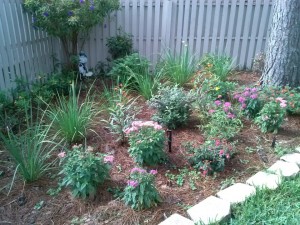Creating a butterfly garden for your Tampa landscape not only brings additional flower color and interest to a sometimes dull landscape, it beckons the "flying flowers"....butterflies! As well, butterfly attracting plants are like any other plant in a landscape, and it is easy to incorporate some or many of them into your existing plan.
To attract butterflies to your landscape, you will need nectar producing plants (for the adult butterflies), larval food plants (for the caterpillars) and a water source such as a shallow pool of water, or wet soil, for the butterflies to drink from. Butterflies tend to prefer full sun or part shade and plants that have flowers with short tubes in the colors purple, red, orange, or yellow. As well, each butterfly's larvae (caterpillar) usually has a strong preference to the type of plant that it feeds on, so you must take that into consideration if you would like to attract a particular type of butterfly, or a wide variety. I will list some of the recommended larval foods below, along with the type of butterfly that it will attract.
Designing your butterfly garden incorporates the same design principles as any other type of landscaping design: leave enough room for larger growing plants (background), allow proper spacing for mid-sized plants, and place the shorter growing butterfly attractors in the front. If you have a rather mature existing landscape, and would like to add some butterfly attractors, just pick from the lists below and find some that will be the right size to fit in around your current design. Or, you can designate an entire area, and use both butterfly attracting plants, and non-attracting plants to add texture and interest.
Consider adding any of these low maintenance and easy to care for butterfly attractors to your butterfly garden (listed by growth size):
Larger growing (4' and up):
- Bush Allamanda
- Dwarf Firebush
- Cassia
- Butterfly Bush
- Porterweed, red or blue
- Passion Vine
- Jatropha
- Golden Dewdrop
- Vitex
Medium growing (2'-3'):
- Penta
- Lantana
- Milkweed
- Golden Shrimp Plant
- Salvia, many varieties
- Sunflower
- Necklace Pod
- Coreopsis
- Ixora
Smaller growing plants (under 2')
- Whirling Butterfly (Guara)
- Verbena
- Stoke's Aster
- Gaillardia
- Zinnia
- Cosmos
- Alyssum
To encourage as many types of butterflies to visit, and perhaps to stay for a while, you will have to add larval plants to provide a host plant for the adults to lay eggs on and, ultimately, for the caterpillars to feed on. The larval plants will be eaten perhaps completely, or with bite notches in the leaves, but this is their purpose. Here is a list of more common larval plants, and what butterfly they are a host plant for:
- Passion Flower (Zebra Longwing, Gulf Frittilary, Julia)
- Milkweed, Asclepia (Monarch, Queen)
- Carrots, Parsley, Dill (Black Swallowtail)
- Legumes (many Sulphurs, Skippers)
- Citrus (Giant Swallowtail)
By adding either a simple or an expansive butterfly garden to your Tampa landscape, you can bring another dimension to your outdoor living space, as well as an element of wonder as you watch these graceful creatures flit about your flowers. A butterfly garden is guaranteed to bring joy and serenity to all that witness it's multiple layers of beauty.

